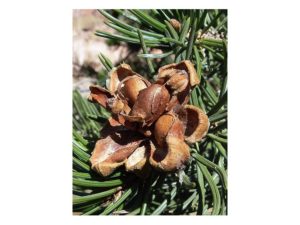Piñon Pine (Pinus edulis)
By Laurie McGrathAlso known as two-needle pine or nut pine, piñon pine is New Mexico’s state tree. Slow-growing and long-lived, it needs only 10 to 20 inches of water per year and is an excellent tree for supporting our native ecosystem. When planted in groups, piñon trees produce much-valued piñon nuts. The trees are an important cover for birds year round, including pinyon jays, Clark’s nutcrackers, Steller’s and western scrub jays, hairy woodpeckers, white-breasted nuthatches, and mourning doves.The pinyon jay and the piñon pine are deeply connected for survival. The jays depend on the nuts the trees produce as a primary source of food. According to New Mexico Wildlifemagazine, “Pinyon jays can remember, months later, and even under snow, the locations where they have stored piñon pine seeds. The few locations that are forgotten promote new growth. The relationship between the tree and the bird is critical to the survival of both.”Planting and care:Piñon pines are available at nurseries. (If you wish to start from seed, detailed instructions are available here.) They like dry, rocky soils. Plant in an area that is not frequently irrigated and where water does not collect. Over-watering can lead to root fungus. But adequate water is required to keep trees healthy and more resistant to pests. During the first winter irrigate every 10 to 12 days. As the tree matures, go to once a month during winter if there is no snow on the ground and every 10 days to two weeks in summer depending on rainfall.Landscape use:Evergreen tree attractive to wildlife; provides winter interest; can make an attractive windbreak. Flower type:inconspicuousBloom time:summerHeight:15–20 feetWidth:15–20 feetExposure:full sunZones:5–8Soil moisture:lowReferences:Darr, Peggy. Pinyon jays & piñon pines(New Mexico Wildlife, Spring 2017)Santa Fe Native Plant Project, A Guide to Native Plants for the Santa Fe Landscape, 2018Utah State University Forestry Extension, Pinyon Pine (Pinus edulis)
Flower type:inconspicuousBloom time:summerHeight:15–20 feetWidth:15–20 feetExposure:full sunZones:5–8Soil moisture:lowReferences:Darr, Peggy. Pinyon jays & piñon pines(New Mexico Wildlife, Spring 2017)Santa Fe Native Plant Project, A Guide to Native Plants for the Santa Fe Landscape, 2018Utah State University Forestry Extension, Pinyon Pine (Pinus edulis)
